Upside-down in the chilly water, I crank my blade up to the surface, sweep it out to the side and hip snap to drive my upper body through the surface.
Then I raise my head, stall and plunge back underwater–but not before filling my lungs with a big gulp of fresh air.
Again I crank my blade to the surface, sweep, hip snap, raise my head, gulp air and–splash back seaward. It is my third failed roll and a carbon copy of the first two ragged attempts.
I continue the process a fourth and a fifth time. I’m running out of breath as well as feeling the onset of an ice-cream headache.
On my sixth attempt, I pause, focus and slow everything down: I sweep cleanly and hip snap, and this time I keep my head down, ear pasted to shoulder, and rise up easily, modeling the best “instructor’s demonstration technique” I can muster. “So that’s what the ‘cass-a-roll’ drill looks like.”
I gush, with all the enthusiasm of Tom Sawyer whitewashing a fence. “Now you try it!” My class of four floats around me in their kayaks, alternately nodding their heads in understanding and shaking them in disbelief: You want us to do what?! I can see I’ve piqued their interest, but no one is quite convinced to pick up a paintbrush just yet.
The cass-a-roll drill, along with the other breath-holding exercises presented here, was designed to help students learn to relax after capsizing, whether they’re going to try a roll, as in this drill, or simply wet exit.
Its purpose is to increase your tolerance for missing your roll, especially in a “combat roll” situation, when you’ve accidentally tipped over in rough seas. It’s a great confidence booster, and it really helps you learn to overcome the panic that often sets in after an unexpected capsize.
As I’ve discovered from years of teaching, most paddlers tend to bail out after only a roll attempt or two. In small part, this is due to running out of air, but mostly it’s psychological: people simply panic.
A missed roll washes away confidence. So the cass-a-roll drill is designed to help build confidence by practicing missing rolls on purpose, as many times as possible, before finally rolling up. If you usually wet exit after only one or two tries, you can train yourself fairly quickly to push it to three or four. Once you get up to four, it’s not that hard to build up to six or eight, or even more.
After a bit more cajoling, I soon have everyone in class cass-a-rolling and practicing other confidence-building drills. Whatever your skill level–whether you’re just learning to roll, your roll is basically bombproof or you’re a non-roller just hoping to become more comfortable after a capsize–the following drills can help you learn to be more relaxed and comfortable, and ultimately more successful, when you find yourself upside-down in the drink.
These drills are partly about training yourself to take deeper, bigger breaths and partly about teaching yourself to relax so you don’t burn that breath of air so quickly.
I’ve modified several of them from practice drills used by competitive free divers, those freaks of nature who, through dedicated practice of breath-control techniques, are able to remain underwater for several minutes at a time (some of them diving to depths of 100 to 200 feet or more) with only a mask.
My own meager training last year enabled me to double my breath-hold time after only a week of practicing the on-land drills, then nearly double that again until I began to plateau a week or so later.
I was easily able to enjoy one- to two-minute bottom times and could push it to three minutes with some effort. I routinely dived to 30 or 40 feet and eventually reached a maximum depth of over 60 feet. I quickly saw the relevance for kayakers to train to relax and hang out underwater.
Deep “Orca” Breaths: The Key to Success
The ability to take a quick, deep breath is a cornerstone skill to all the breath-hold drills presented here. While you sit reading this article, with each breath you are likely exchanging in the neighborhood of a mere 15 percent of total lung volume that’s typical of most humans.
That’s less than a liter of your four-to-five-liter average capacity. Compared to the 90 percent exchange common among most marine mammals, it’s easy to see that we Homo sapiens are gross underachievers in this arena. Learning to boost that percentage closer to that of our fin-footed mammalian cousins, however–what I call orca breathing–is fairly simple and can quickly reap huge results.
If you’ve ever heard orca whales breathe, you have a sense of how much air they move in and out of their lungs. There is this sudden huge whoosh of exhalation, followed immediately by a giant, equally sudden but less obvious in-rush of breath.
Then they dive. The whole air exchange–again some 90 percent of their total volume–takes barely a second. Not bad for an animal with lungs about the size of your cockpit! With just a little practice, the benefits of orca breathing can be yours.
Start slowly at first, by practicing to increase your exchange of air. If you’ve done any yoga breathing, you’re probably already familiar with this. (Most competitive free divers, by the way, are proponents of meditation and deep-breathing techniques.)
The main difference is learning to do it quickly. First, take a couple of slow deep breaths. See how much air you can exhale, as if you were trying to blow out all 969 candles on Methuselah’s birthday cake. You might try bending over and even pressing on your stomach to squeeze out as many cc’s (cubic centimeters) as you can of that final liter in your lungs.
Then breathe in slowly–the trick is to fill your lungs from the bottom up–by pushing your belly out first, then filling your chest, then finally doing what free divers refer to as “packing” your upper chest and neck area.
When you have taken as big a breath as you can, raise your chin and extend your neck, and try “sipping” in a few more cc’s of oxygen through pursed lips, as if sipping up the last few drops of a milkshake through a straw.
Take as many sips as you can, until you can’t fit any more air into your lungs. Then hold for a few seconds and focus on what it feels like to have your lungs so full of air. Repeat this exercise several times until you have a good sense of what a deep lungful of air feels like.
But be careful–taking more than three deep breaths in succession can cause you to hyperventilate and pass out, which would be especially dangerous in the water. While practicing, remember to take a few normal breaths between each deep breath.
Now it’s time for orca breathing. Unfortunately, in the context of rolling, we don’t have time for a full, slow, yoga breath.
So imagine rolling up enough to get your head above water but missing your roll and quickly taking a big gulp of air in the second or two that you have before plunging back underwater.
Think about trying to exhale on your way up, and take a big gulp as you stall, so that you don’t breathe in water on your way down. Start slower at first, maybe taking two seconds or so on both the exhale and the inhale. Eventually practice speeding it up to one second or so total. At the end of the “in” breath, hold for a few seconds, then try packing and sipping to see how much more air you can get in.
With practice, you’ll soon find yourself consistently able to gulp from 60 to 90 percent of your lung volume, so that you have little space left for sipping in much more air. Now it’s time to move on to the next step.
Static Apnea Drills
Static apnea is a fancy term for holding your breath while static, that is, sitting quietly relaxed on the sofa (or floating facedown in a pool of water as the competitive free divers do–the world record, by the way, is just over eight minutes!).
Since kayakers don’t have the luxury of several minutes of deep breathing and meditation between rolls, the modification I practice involves single-breath holds, using orca breathing. Blow out and gasp in, doing a quick orca breath, and hold for five seconds.
Repeat this orca breath and five-second hold five times (be careful to stop if you get dizzy; however, hyperventilation should not be a problem because you are holding your breath for several seconds each time and not taking more than one deep breath at a time).
The next step is to try a series of five 10-second holds. Most beginners, I’ve found, can do this fairly comfortably with only a little practice.
The next step is pyramid practice. This does not involve traveling to Egypt, but simply refers to increasing the length of breath holds to a peak, then reversing back down.
For example, using one orca breath between each breath hold, hold for five seconds on the first breath, 10 seconds the next breath, 15 seconds the next, then back down to 10 seconds, then five and stop. When this becomes too easy, try double pyramids–hold twice at five seconds, twice at 10, twice at 15, then back down, twice each at 10 and five–and even triple pyramids.
The point of pyramids is to build confidence by training to reach a peak well beyond the time you need for a roll. Then, as you descend back into the five- or 10-second breath-hold range, still well within the time limit for a typical roll, it’ll seem easy.
But don’t wait until mastering triple pyramids before moving on to the next drills. Just spend five minutes or so to do four to eight pyramids. Start easy and build up to whatever level presents a comfortable challenge: if you attempt a double pyramid and can’t hold your breath twice at 15 seconds, just do one.
You may be tempted to build up into the 20-second range or beyond, and such training certainly has value. But such times are well beyond the context of typical rolling times, and the longer you hold your breath, the more health risks are involved.
While the shorter times I propose should be fairly safe, realize that serious free divers who routinely practice holding their breath for several minutes at a time occasionally develop heart arrhythmia. So as with any new exercise program, check with your physician first.
And if you are serious about learning how to hold your breath for minutes at a time, consider taking a course taught by free-diving professionals. Instead of going for longer breath holds with static apnea, the next step in my progression is to get up off the couch and take the single-breath holds on the road.
Dynamic Apnea Drills
Dynamic apnea refers to holding your breath while exercising, and it’s much more relevant to kayakers. After all, you won’t be sitting on the sofa all “Zenned” out when you capsize.
Walking pyramids is a dry-land, free-diver drill that is particularly effective for paddlers. Start walking at an easy pace. Now, instead of holding your breath for five seconds, take an orca breath and hold your breath for five steps.
Take another orca breath and hold for 10 steps, breathe, hold for 15 steps and so on. Practice the same single, double and triple pyramid drills you used while sitting on the couch.
Stop if you start feeling dizzy so you don’t fall and hurt yourself. Until you’re familiar with how your body responds to the exercises, you may want to practice on a lawn or other soft surface.
While it isn’t that common to get dizzy and fall, it is a possibility. Once you are comfortable with the walking drills, it’s time to take to the water.
It’s a good idea to practice paddling pyramids with a partner, particularly one who knows the Hand of God rescue (SK, June ‘00). While the likelihood of your passing out while practicing is slim, if you did manage to hyperventilate and pass out upside-down, you’ll want someone around who can quickly right your boat with you in it.
Paddling pyramids are performed using the same progression as walking pyramids, only you count strokes instead of steps. A more advanced version of this drill for those with solid rolling skills is to actually roll at the end of each stroke count.
That is, take an orca breath, paddle five strokes, roll; orca breath, 10 strokes, roll; orca breath, etc. When you can do triple paddling pyramids to 15 strokes with rolls in between, you are well on your way to becoming master of breath control, a near amphibious aqua-man or woman!
Reverse Breath Holds
A particularly challenging technique that can be applied to most of the drills here is the reverse breath hold, which refers to taking a big orca breath in, then blowing it out and doing a roll or pyramid practice, either sitting, walking or paddling.
The idea is that you’re practicing after the out breath, with your lungs empty. With a little practice, you’ll be surprised at how long you can hold your breath when you don’t even have any breath to hold.
More “Evil Rolling Drills”
One of my students dubbed the following drills (double roll, roll and hold, crash and roll) my “evil rolling drills” because she found them particularly challenging–more mentally than physically.
Those who are learning to roll can practice them with a paddle float on the paddle to increase their breath-holding confidence without worrying about missing their rolls.
A double roll is simply two rolls on the same breath hold. Take a breath and roll. Capsize again and roll up before taking another breath. The next steps, you guessed it, are the triple and quadruple rolls.
With a little practice, it’s a good challenge for experienced rollers to do four to six rolls (or even more) off a single breath. Since each roll typically takes less than five seconds, the total breath-hold time is only 20 to 30 seconds for half a dozen rolls.
A version of this drill that my students find particularly evil is doing reverse breath holds–breathing out–between double or triple rolls. This teaches you to remain calm and perform physically even if you aren’t able to get a good breath before going over.
The roll-and-hold drill is a rolling pyramid drill. Capsize and count to five, roll up, orca breath, capsize and count to 10 (yes, that’s right, while upside-down under water).
This is an extremely challenging drill in cold water. The ice cream headache will get you long before you get to your first 15, much less any double or triple pyramids! In a swimming pool or warm water, however, this drill can really help teach you to relax and take as much time as you need to set up to execute a nice, clean, unhurried roll.
The crash and roll is a common bomb-proofing exercise where you sprint either forward or backward and lunge into a violent, splashing capsize, even letting go of your paddle with one hand.
The idea is that you are trying to simulate a wipeout in rough water, instead of going over all ready and set up for a roll. While underwater, you have to reorient your paddle before setting up to roll. For a little extra challenge, how about trying a double crash and roll with a reverse breath hold? That is, paddle hard, breath out, crash and roll up twice before taking another breath!
Cass-a-Roll Revisited
I developed this miss-on-purpose drill while teaching a friend named Cass to bombproof his combat roll. His roll was pretty consistent in the swimming pool, but once he got to the ocean, he tended to panic and rush his set up, causing his paddle to dive as he raised his head for air, no matter how many times I yelled “Head up last!” to him. This is a common problem I’ve seen when students take their pool roll out to sea.
By learning to relax while missing your roll several times in succession–and training yourself to grab a quick orca breath between each attempt–you can dramatically increase your ability to remain calm under pressure.
Instead of starting to freak out after missing a roll or two, you train yourself to get used to missing a half dozen or more. Practice this in a controlled situation with a buddy nearby for a bow recovery. Next time you go over in the real world, you won’t be so worried about running out of breath after only one or two attempts.
Surf Rolls and “Arithmetic” Rolls
I have two types of surf rolls I use to teach students to relax and roll in waves. The first is to capsize in the soup zone in front of a small wave and let it wash over you before rolling up. Try bigger and bigger waves as you get more comfortable, and try capsizing early, so you have to wait several seconds before the wave washes over you.
The second version of this is to set up sideways to the waves and let one knock you over–just make sure you are in deep enough water that you don’t hit your head. And of course, you should always wear a helmet whenever paddling in surf.
You can also practice surfing in and broaching on the wave, then window shading–that is, capsizing on purpose toward shore and having the breaking wave roll you several times–to re-create the typical surf-zone capsize.
To teach himself to relax underwater, an instructor friend of mine invented arithmetic rolls. He would capsize with a dive mask and solve a simple algebra problem on a dive slate before rolling back up. If, like me, you’re more scared of algebra than of drowning, you might consider word puzzles or maybe a quick game of tic-tac-toe or hangman between partners.
The point is to realize that rolling–and the ability to hold your breath calmly underwater–is as much a mind game as it is a physical skill. It has as much to do with training your body to perform with less oxygen as it does with learning to accept that your body can do without air for a lot longer than your panicky mind may think. And panic only burns oxygen faster.
By practicing these drills, you’ll gain both mental confidence as well as muscle memory. Even if you feel confident that you can easily hold your breath for 20 seconds, it’s another thing when you train your muscles to know this as well. This lets your body take over and tell your mind in essence to “Chill out, man–we’ve got plenty of oxygen in here.”
With daily practice of the dry-land drills, you should quickly see big improvements in your ability to comfortably hold your breath. Even two or three times a week should give noticeable results in a week or so.
Once you are familiar with the various techniques, it’s easy to practice them throughout the day. I often play around with holding my breath while walking down the street, standing in line at the grocery store, wherever. I’ll hold my breath while working at the computer–write a sentence, orca breath, write two sentences, etc.–or even sitting at stoplights.
On weekends (or whenever you paddle), try practicing paddling pyramids. I’ll at least do this even if I don’t feel like rolling and getting wet.
But I usually do. I find the “evil rolling drills” challenging and fun, so I usually do end up wet and breathless before I land for the day. I’ve actually come to enjoy practicing these drills so much–along with the extra “bottom time” and confidence they’ve added to my already bomber rolling skills–that you might even say they’ve breathed new life into my rolling practice!


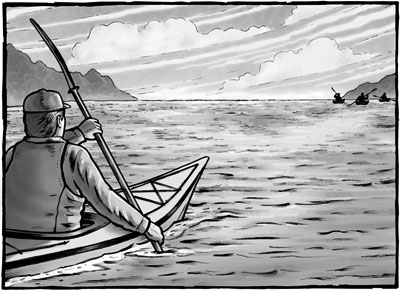 In the Neth
In the Neth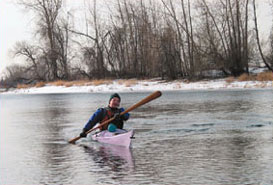
 After some hit-and-miss route-finding through the ice, a few chunks of which hit the kayak, I reach the Old Port. A couple of ducks sit on the thin ice of the still-water basin. At first, the ice is like paper, then it thickens very progressively. I break over five kayak lengths of it until I find ice too strong to be broken by the paddle, but not strong enough to support the kayak’s weight. Unable to dig my paddle in, I can’t exert enough force to advance. Because the kayak itself is not supported by the ice, I can’t stand or even crawl on it. It looks like my planned stop won’t be possible today. This is yet another reminder that, in the winter, you don’t always get to do what you’d like, so you can only take advantage of what the conditions allow. Flexibility is a must.
After some hit-and-miss route-finding through the ice, a few chunks of which hit the kayak, I reach the Old Port. A couple of ducks sit on the thin ice of the still-water basin. At first, the ice is like paper, then it thickens very progressively. I break over five kayak lengths of it until I find ice too strong to be broken by the paddle, but not strong enough to support the kayak’s weight. Unable to dig my paddle in, I can’t exert enough force to advance. Because the kayak itself is not supported by the ice, I can’t stand or even crawl on it. It looks like my planned stop won’t be possible today. This is yet another reminder that, in the winter, you don’t always get to do what you’d like, so you can only take advantage of what the conditions allow. Flexibility is a must.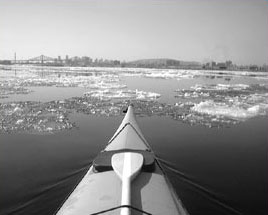 For my outings, I start by layering synthetic fleece. The amount of fleece I put on depends on temperature and wind speed. For conditions below –5°C/23°F, I start with a base of four layers. The first layer is moisture-wicking fleece long underwear, which covers my legs, torso, arms and the bottom of my neck, in the area just below the dry-suit gasket.
For my outings, I start by layering synthetic fleece. The amount of fleece I put on depends on temperature and wind speed. For conditions below –5°C/23°F, I start with a base of four layers. The first layer is moisture-wicking fleece long underwear, which covers my legs, torso, arms and the bottom of my neck, in the area just below the dry-suit gasket.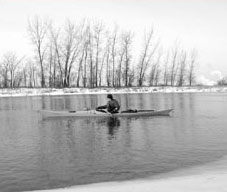
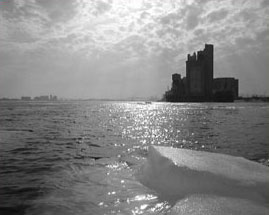
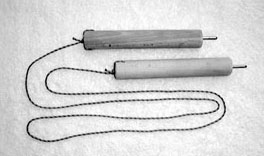
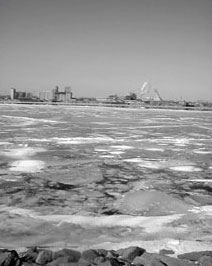
 As with any kayak trip, a day of winter paddling starts at the water’s edge. In summer, getting to the water is usually straightforward: drive to the water, park, unload and launch. In winter, it’s not always as simple. A weak ice edge, where ice meets water, can complicate entering the water or make it impossible. Drifting ice, at the mercy of wind and current, can alter course during the day, and rapidly evolving ice conditions can hinder landing. Thus, scouting is essential to get to open water and to note places to take out if the ice shifts.
As with any kayak trip, a day of winter paddling starts at the water’s edge. In summer, getting to the water is usually straightforward: drive to the water, park, unload and launch. In winter, it’s not always as simple. A weak ice edge, where ice meets water, can complicate entering the water or make it impossible. Drifting ice, at the mercy of wind and current, can alter course during the day, and rapidly evolving ice conditions can hinder landing. Thus, scouting is essential to get to open water and to note places to take out if the ice shifts.
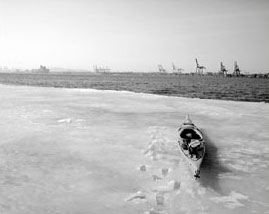
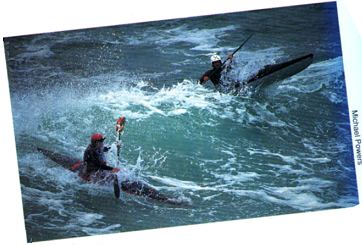
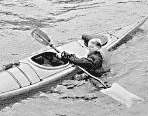 I just recently talked with a sea kayaker in Chicago who described an incident at Cape Fear in North Carolina. Garrett showed me some photographs of a rough sea and proudly explained how he had paddled right out through all the breakers and then sat marking time,
I just recently talked with a sea kayaker in Chicago who described an incident at Cape Fear in North Carolina. Garrett showed me some photographs of a rough sea and proudly explained how he had paddled right out through all the breakers and then sat marking time, 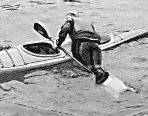 punching through each wave as it came.
punching through each wave as it came.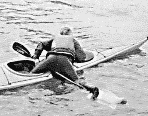 cockpit, but every time a wave hit me, the paddle sheared around alongside the kayak like a pair of scissors closing and I capsized again.
cockpit, but every time a wave hit me, the paddle sheared around alongside the kayak like a pair of scissors closing and I capsized again.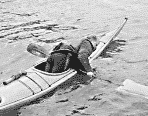 his time trying to climb back in, and that he had better swim for shore. His account made me think about self-rescues, about the dependence of many paddlers on equipment rather than on paddling skills and their reliance on self-rescue rather than group rescue. I see so many kayakers carrying an inflatable paddle float on their deck alongside a stirrup bilge pump. But I wonder how many of those paddlers have practiced in the kinds of waters they would capsize in? How many others, like Garrett, believe that self-rescue is not possible in rough water?
his time trying to climb back in, and that he had better swim for shore. His account made me think about self-rescues, about the dependence of many paddlers on equipment rather than on paddling skills and their reliance on self-rescue rather than group rescue. I see so many kayakers carrying an inflatable paddle float on their deck alongside a stirrup bilge pump. But I wonder how many of those paddlers have practiced in the kinds of waters they would capsize in? How many others, like Garrett, believe that self-rescue is not possible in rough water?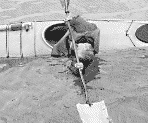 While the paddle float was devised as a way to improvise an outrigger for self-rescue, its best use, in my opinion, is as an aid to a reentry and roll. Once the rudimentary principles of a roll are mastered, a reentry and roll with a paddle float can offer a reliable self-rescue, even though rolling without the float might still
While the paddle float was devised as a way to improvise an outrigger for self-rescue, its best use, in my opinion, is as an aid to a reentry and roll. Once the rudimentary principles of a roll are mastered, a reentry and roll with a paddle float can offer a reliable self-rescue, even though rolling without the float might still 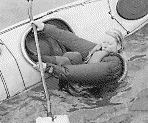 be elusive.
be elusive. from the side as possible. Grip the near side of your cockpit with your other hand. Lie back in the water. Hold your breath and swing your feet into the cockpit between your hands. Still gripping both sides of the cockpit, wriggle yourself into your seat, and with your feet on the foot braces, grip firmly with your knees.
from the side as possible. Grip the near side of your cockpit with your other hand. Lie back in the water. Hold your breath and swing your feet into the cockpit between your hands. Still gripping both sides of the cockpit, wriggle yourself into your seat, and with your feet on the foot braces, grip firmly with your knees.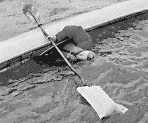 grasp the paddle shaft with both hands and gently pull down against the buoyancy of the paddle float until your head reaches the surface and you can breathe and see what you are doing.
grasp the paddle shaft with both hands and gently pull down against the buoyancy of the paddle float until your head reaches the surface and you can breathe and see what you are doing.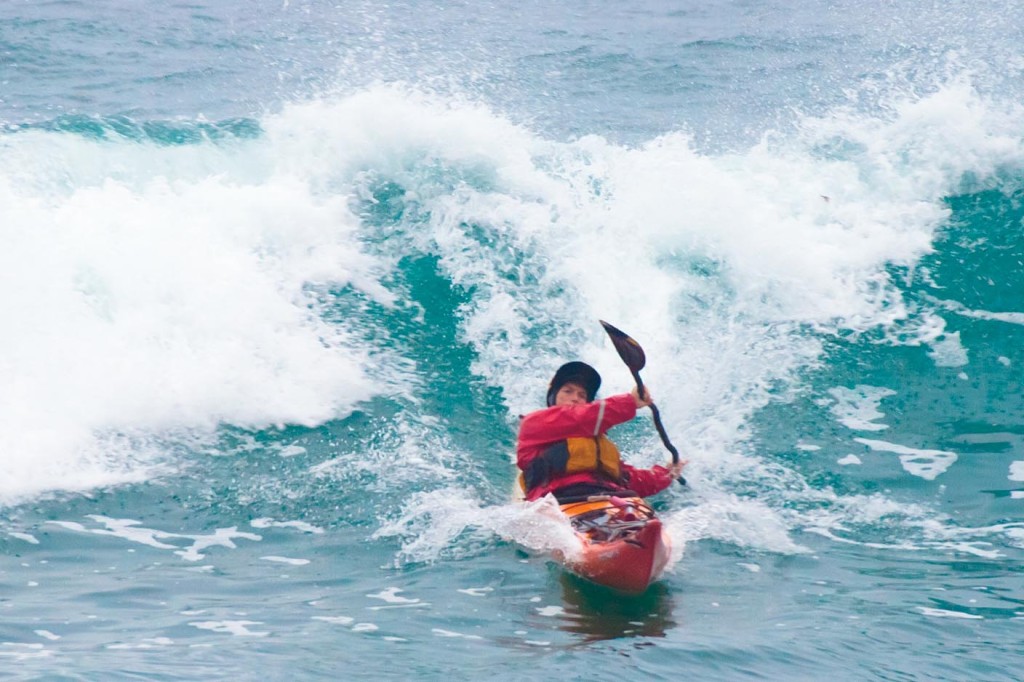 Waves with shallow faces, such as the one pictured here, are better for sea kayak surfing than waves with steep, hollow faces.
Waves with shallow faces, such as the one pictured here, are better for sea kayak surfing than waves with steep, hollow faces.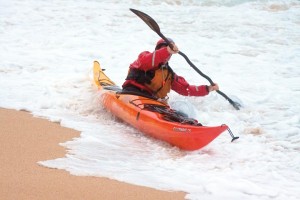 Most kayaking accidents happen at the juncture of land and sea–right next to the surf
Most kayaking accidents happen at the juncture of land and sea–right next to the surf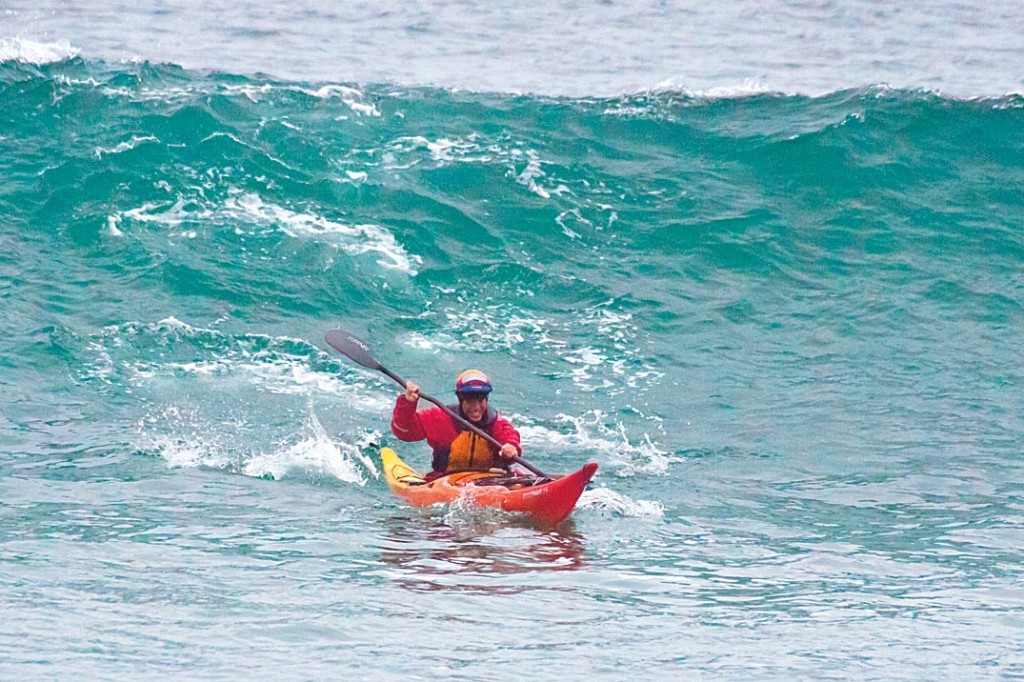 When scouting for waves, look for smooth, open faces from longer period swells that break down the line rather than closing out all at once.
When scouting for waves, look for smooth, open faces from longer period swells that break down the line rather than closing out all at once.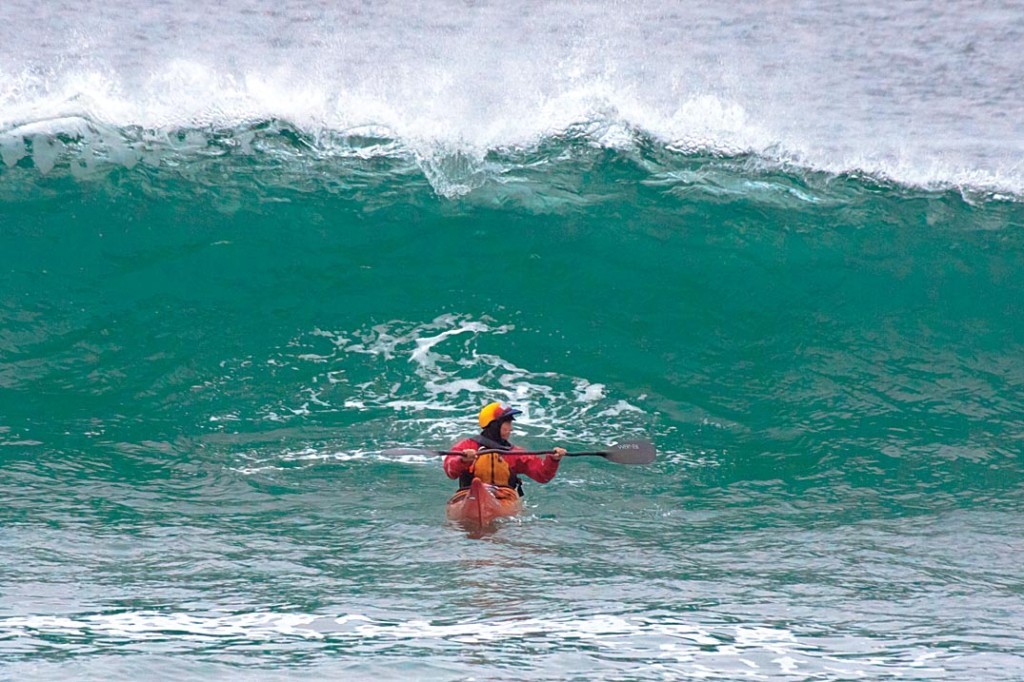 Under the wave’s lip, perpendicular to the face, is not the ideal position for a sea kayaker. Surfers call this being “too deep.”
Under the wave’s lip, perpendicular to the face, is not the ideal position for a sea kayaker. Surfers call this being “too deep.”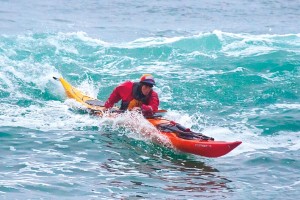 Leaning forward helps you regain position in front of the wave’s energy. Alternatively, leaning back helps shift your weight to keep the bow above water.
Leaning forward helps you regain position in front of the wave’s energy. Alternatively, leaning back helps shift your weight to keep the bow above water.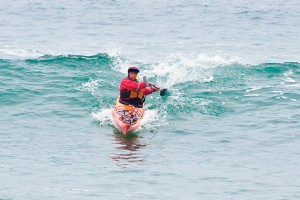 Edging away from the stern rudder is a good way to make gradually sweeping turns
Edging away from the stern rudder is a good way to make gradually sweeping turns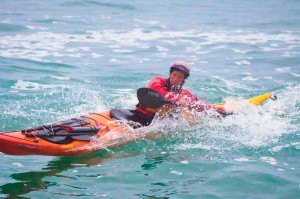 Low brace turns are good for either getting off the wave before shore or carving turns on gently sloping waves.
Low brace turns are good for either getting off the wave before shore or carving turns on gently sloping waves.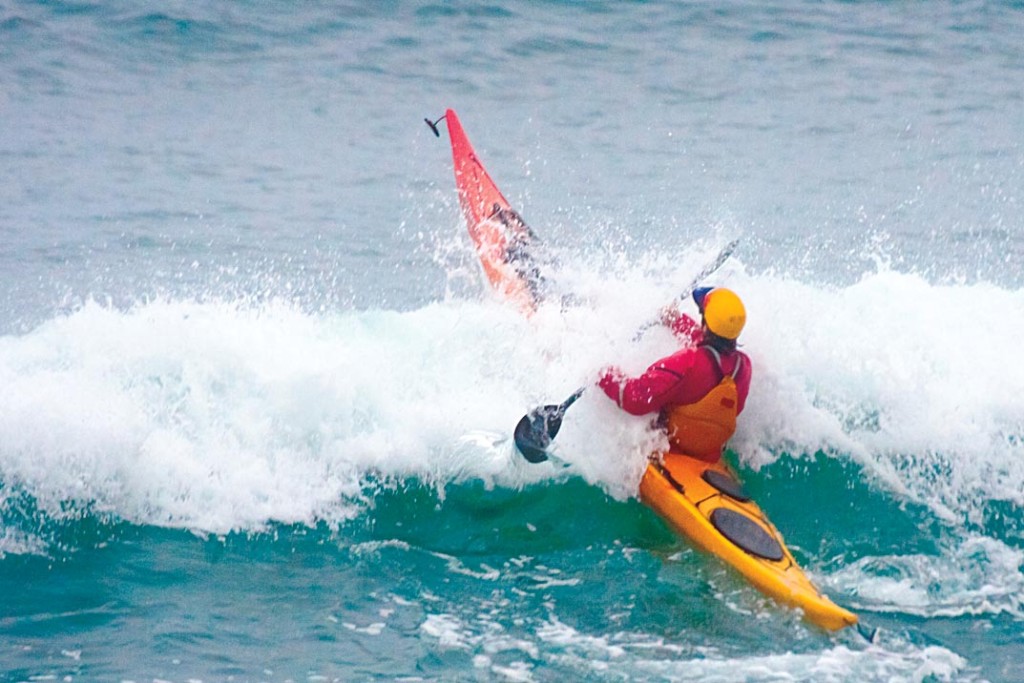 Now, get out there!
Now, get out there!